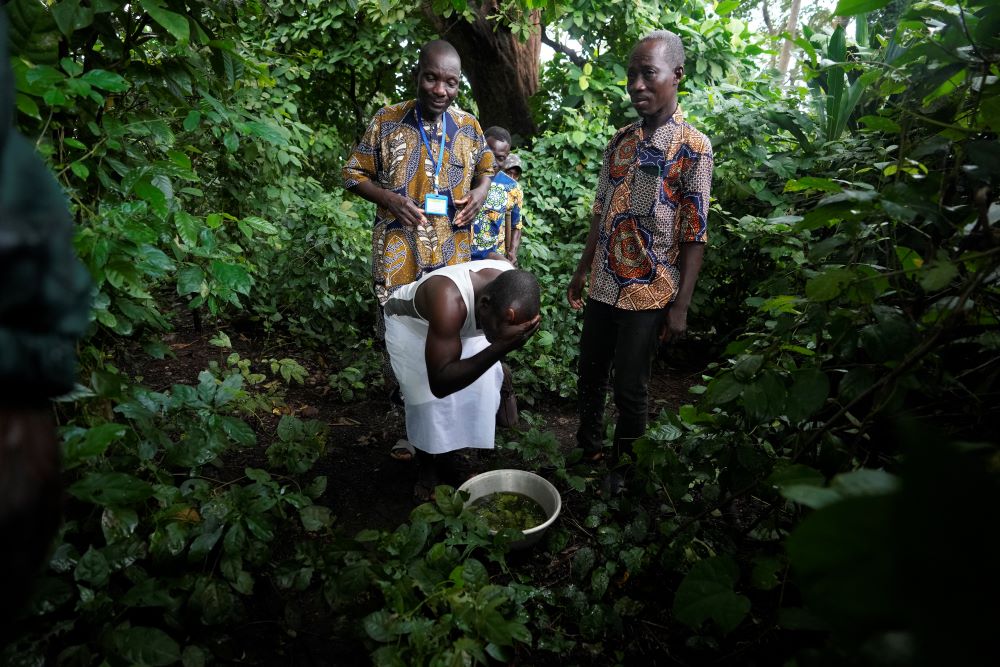
A voodoo worshiper washes his face after visiting the Bohouezoun sacred forest in Benin, on Thursday, Oct. 5, 2023. As the government grapples with preserving the forests while developing the country, Voodoo worshippers worry the loss of its spaces could have far reaching effects. (AP/Sunday Alamba)
For many people in Benin, the forests empowered them before they were born, or in the first months of their lives.
Barren women performed Voodoo rituals by sacred trees to get pregnant. Others were brought as newborns by parents seeking to ward off evil spirits. Some entered at a crossroads as adults, asking for guidance.
In the cradle of Voodoo, the forests were places of hope. Yet as the woodlands shrank, due to economic development and other factors, it has dealt a blow to communities struggling to protect the spirits believed to live within them.
In many cases, according to believers, the spirits fought back.
When residents in the village of Houeyogbe agreed to let the government destroy much of its forest to build roads and install electricity, locals say the spirits unleashed a plague, with inexplicable deaths and mounting illnesses.
In Ouidah, Benin's epicenter of Voodoo, a gas station that replaced the Aveleketezou forest years ago has not turned a profit, residents say. Station employees said that when they filled cars with gas, it turned to water.
Advertisement
Benin is home to thousands of sacred forests, which believers say are vital to a religion rooted in nature. They see the forests as homes for spirits, which priests pray to and seek guidance from.
But for decades the West African nation's forests have been threatened, initially by anti-Voodoo attacks and then by the expansion of farming and urbanization.
Between 2005 and 2015, the total area of Benin's forests decreased more than 20%, with the rate of deforestation continuing at more than 2% a year, according to the World Bank.
As the government grapples with preserving the forests while developing the country, Voodoo worshippers worry the loss of its spaces could have profound effects. Not only is it an environmental concern but believers say it threatens the social fabric of Benin's 13 million people — approximately 11% of whom practice Voodoo.
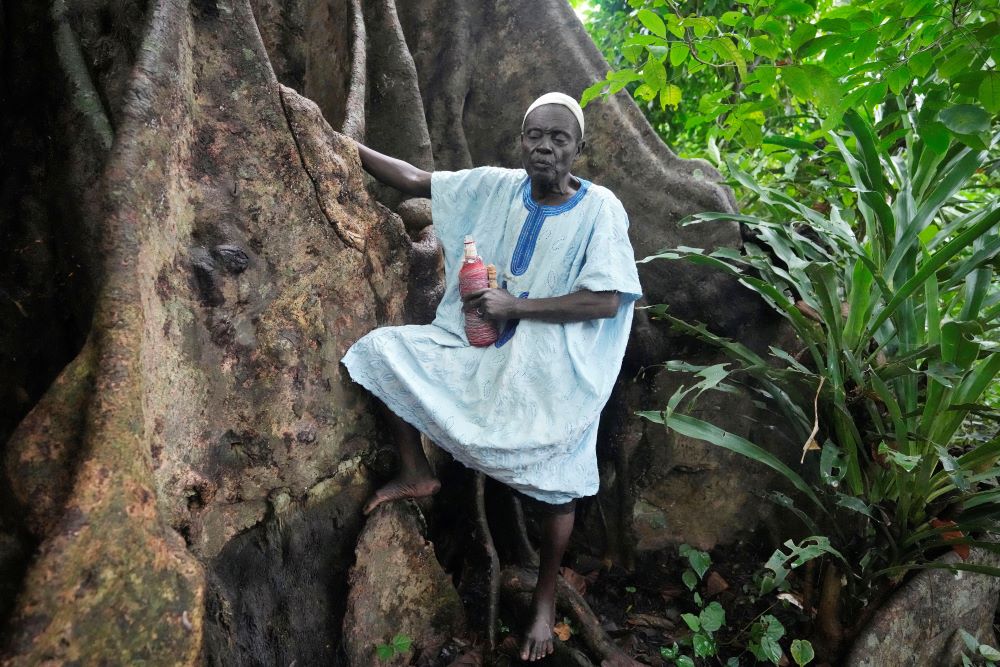
Gilbert Kakpo, a Voodoo priest, stands by a a sacred tree, who he claims is the protector of women at the Bohouezoun sacred forest in Benin, on Thursday, Oct. 5, 2023. "Our divinity is the protector of women," he says. "If you're a woman who's had miscarriages or has given birth to stillborn children and you come here for rituals, you'll never endure those hardships again ... I can't count the number of people who have been healed or treated here." (AP/Sunday Alamba)
"When (the government) brought roads to our region and we had to stop everything in the sacred forest, people started getting sick and having all kinds of problems," said Benoit Sonou, a Voodoo priest who witnessed the destruction of his community's forest as a young man.
Some 50 years later, he sits on the gravel road where the forest once stood, beside the two remaining trees the community salvaged. They're cordoned off behind a concrete wall in hopes they won't be touched.
One of the world's oldest religions, Voodoo originated in the kingdom of Dahomey — present-day Benin — and is rooted in animism, the belief that all things, from rocks and trees to animals and places, have a spirit. Today, millions of people practice it, turning to Voodoo priests to perform rituals to ward off evil spirits, overcome illness and achieve professional and personal success.
While Benin has many Christians — comprising nearly half the population — Voodoo is embedded in most people's lives.
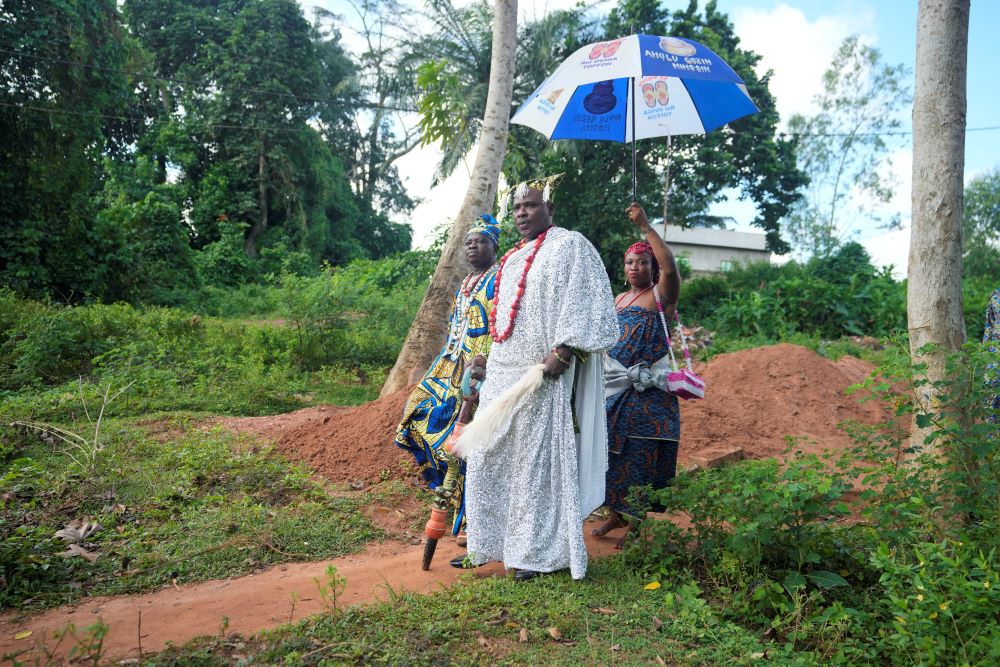
His Majesty Oviga Toffon, king of the Adjarra region, attends a meeting at the Oro sacred forest in Benin, on Wednesday, Oct. 4, 2023. "We don't want any topographic or urbanization work that will destroy our forests and bring instability to our community," and the divinities guarantee peace of mind and stability and shouldn't be angered, he says. (AP/Sunday Alamba)
Gatherings don't begin without dropping water on the ground, a ritual that pays respect to ancestors. Initiation into Voodoo takes many years. And with few exceptions, only those initiated are allowed to enter the sacred forests. Many of the parks ban women, due to beliefs they'll go mad if they enter. The men must enter naked.
In the West, Voodoo is sometimes regarded as evil, or conflated with witchcraft. In Benin, Voodoo priests say the religion is grounded in positivity, based on tolerance and acceptance, and abides by a strict set of rules.
Carefully guarded stories about which spirits inhabit which forests have been passed down through generations. Believers say the spirits usually live in baobab or Iroko trees, considered the most sacred, and are places where priests perform the rituals, such as drinking blessed water or gin, eating cola nuts or sitting in a sacred spot, such as inside a tree.
"The sacred forest is a vital area," said Dada Daagbo Hounon Hounan II, the Supreme Spiritual Voodoo Chief. "It's an area that enables the reception of positive energies and positive vibrations to direct and rule the world."
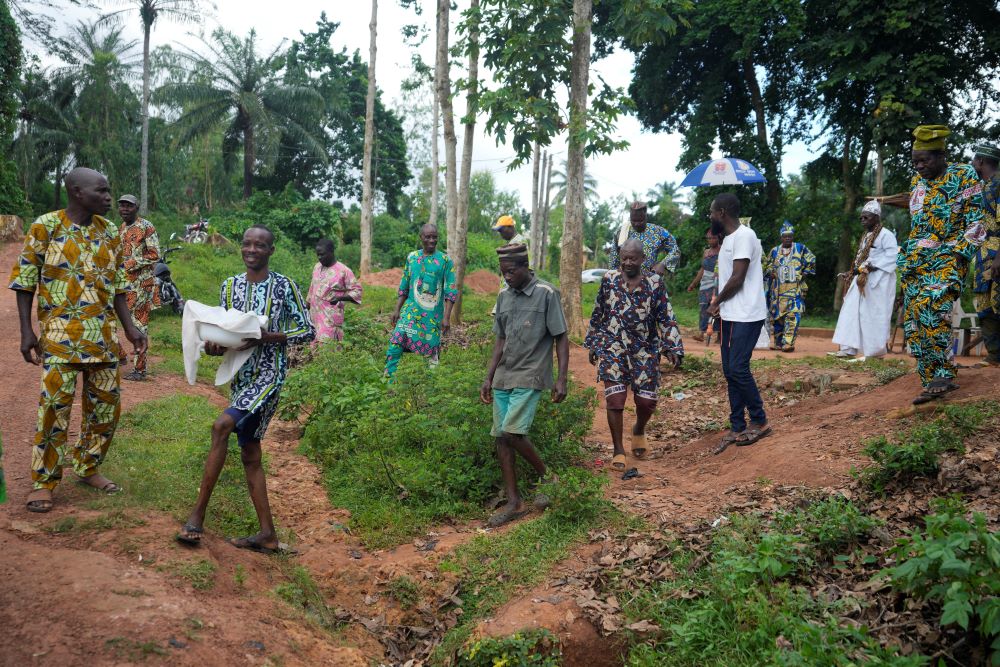
Voodoo worshippers carry a sacrifice wrapped in white cloth to the Oro sacred forest in Adjarra, Benin, on Wednesday, Oct. 4, 2023. Many villagers say the creation of roads, water and electricity was necessary to feel more connected to the rest of the country. Others say allowing any development to overtake the forests is sacrilegious and risks angering the spirits. (AP/Sunday Alamba)
Only certain priests can communicate with the spirits, doing so through chants, prayers or making noise like ringing a bell.
During an October visit to several sacred forests in southern Benin, The Associated Press heard what sounded like intense swirling wind emanating from two forests after Voodoo priests called to the spirits.
It's unclear what the sounds were, but religion experts say what matters is that people believe they can communicate with the forest.
"It all points back to the idea that we don't live in a world where the only actors are the human ones," said Danny Hoffman, a cultural anthropologist who is director of the University of Washington's Henry M. Jackson School of International Studies.
Losing these forests eliminates places for experimentation and innovation, he said. "When we lose spaces demarcated for spiritual practices, these are spaces where people come together and try to understand how they're going to respond to new challenges and new difficulties."
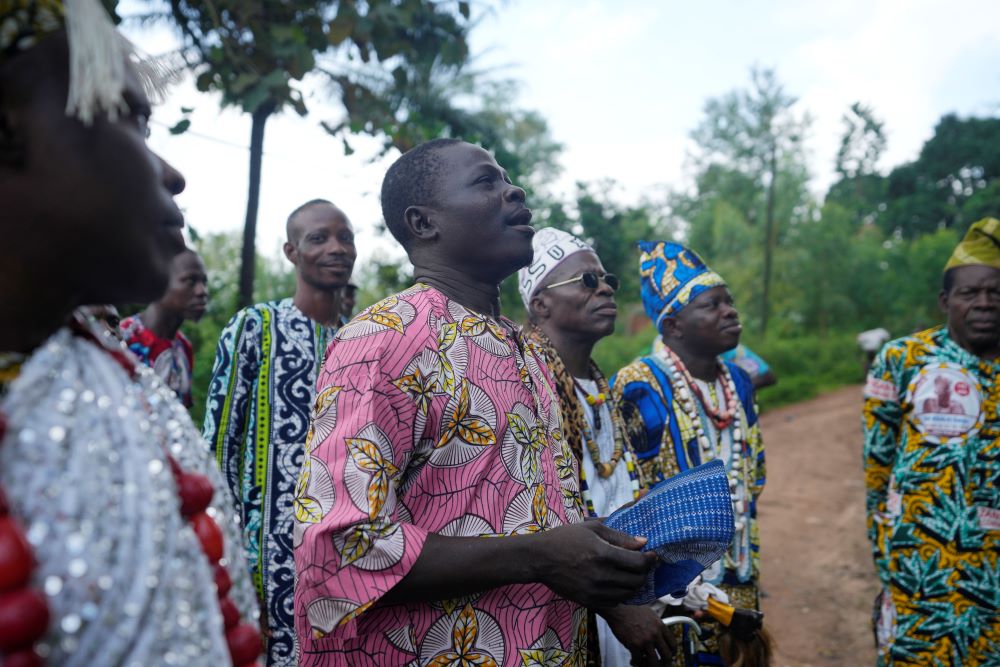
A voodoo priest calls on the spirit outside the Oro sacred forest in Adjarra, Benin, on Wednesday, Oct. 4, 2023. As the government grapples with preserving the forests while developing the country, Voodoo worshippers worry the loss of its spaces could have far reaching effects. (AP/Sunday Alamba)
Standing in front of a sacred tree, priest Gilbert Kakpo said women with childbirth troubles go there for help.
"Our divinity is the protector of women," he said. "If you're a woman who's had miscarriages or has given birth to stillborn children and you come here for rituals, you'll never endure those hardships again ... I can't count the number of people who have been healed or treated here."
It's hard to quantify how much sacred space has been lost in Benin, and to pinpoint the root cause.
Locals and officials look to the early 1970s. The government at the time cracked down on Voodoo believers, arresting and lynching people and chopping down trees deemed sacred. Decades later, new administrations made amends with the Voodoo community, but by then development had surged.
Between 2001 and 2012 approximately 45% of Benin's sacred forests had disappeared or were diminished, according to the Circle for Safeguarding of Natural Resources. The aid group tries to preserve sacred forests by working with communities to demarcate boundaries, raise awareness about cutting trees and teach people how to financially benefit through honey harvesting or snail farming.
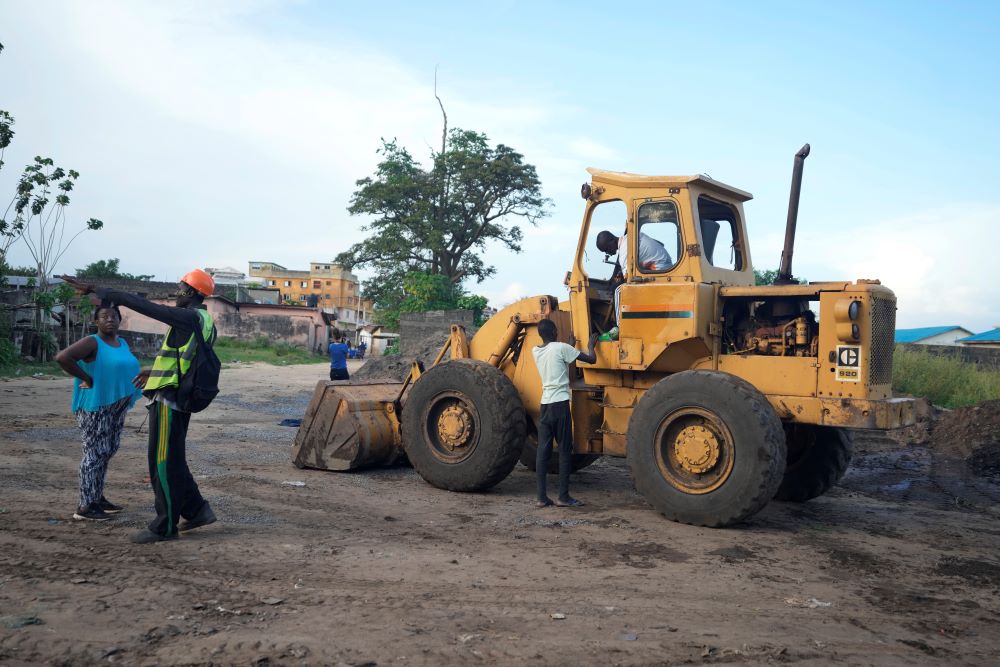
Construction workers work near the last remaining sacred tree of the Odjou Ekoun Oro forest in the village of Houeyogbe, Benin, near Port Novo, on Wednesday, Oct. 4, 2023. Between 2001 and 2012 approximately 45% of Benin's sacred forests had disappeared or were diminished, according to the Circle for Safeguarding of Natural Resources. (AP/Sunday Alamba)
Urbanization and desertification shrank the forests, but the biggest factor was agricultural expansion driven by poverty, said Bienvenu Bossou, the group's executive director. Benin's economy depends on agriculture exports, notably cotton and cashew nuts, and Bossou says many people — unable to afford fertilizer — expanded their farms into the forest to use its rich soil.
Others blame the government's development push.
Earlier this year in the village of Ouanho, residents said the government destroyed part of the forest to construct roads without notice. Now the spirits, which need protection, are too exposed by the fading forests, residents say.
The government is doing what it can to protect the spaces, but can't always ask for permission to build, one official said.
"The state is doing its best not to construct where there are sacred forests. We often ignore the sacred forests because we don't want them to prevent us from developing the country," said Florent Couao-Zotti, the technical adviser for the ministry of culture.
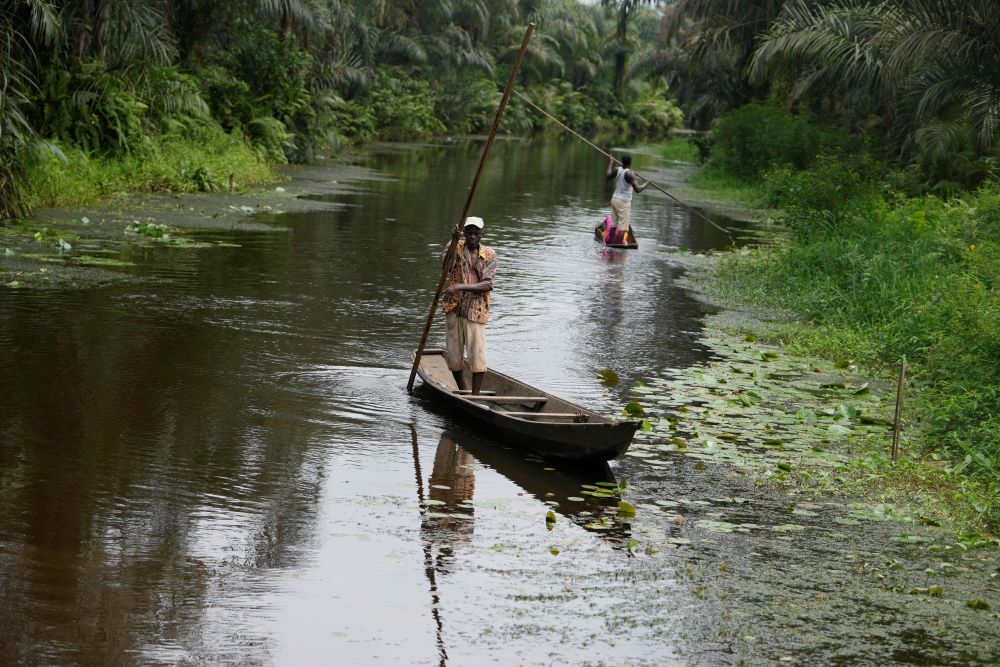
A man paddles a canoe near a Voodoo sacred forest in Adjarra, Benin, on Wednesday, Oct. 4, 2023. As the government grapples with preserving the forests while developing the country, Voodoo worshippers worry the loss of its spaces could have far reaching effects. (AP/Sunday Alamba)
The government has banned cutting down trees without state approval and since 2016 has invested some $3 billion into the culture and tourism sectors, which will indirectly help the forests, he said.
As Benin's population grows at nearly 3% a year, communities are trying to reconcile how to develop their land while preserving the forests.
"It's very hard to see how we can cope with development while maintaining our cultural heritage," said Andre Todonou, a youth leader in Houeyogbe, where the forest was reduced to a handful of trees.
Many villagers say the creation of roads, water and electricity was necessary to feel more connected to the rest of the country. Others say allowing any development to overtake the forests is sacrilegious and risks angering the spirits.
"We don't want any topographic or urbanization work that will destroy our forests and bring instability to our community," said His Majesty Oviga Toffon, king of the Adjarra region. The divinities guarantee peace of mind and stability and shouldn't be angered, he said.







